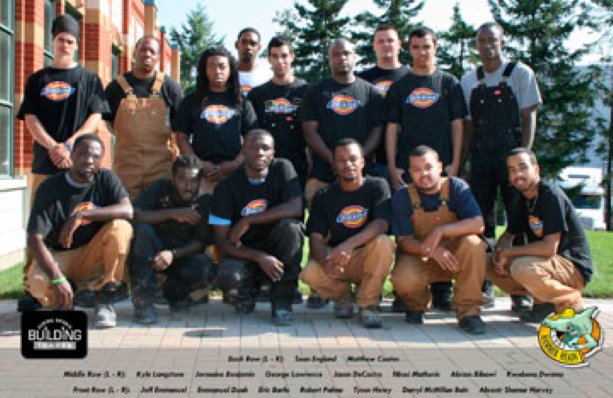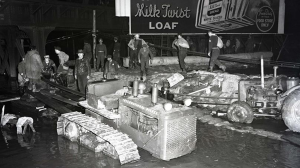A youth training program orchestrated by Central Ontario Building Trades (COBT) has achieved an enviable placement rate over its short history, with more than 85 per cent of grads going on to apprenticeship training programs in the construction industry.
Front Row (L – R): Jeff Emmanuel, Emmanuel Duah, Eric Barfo, Robert Palma, Tyson Henry, Darryl McMillan-Bain, Absent: Shamar Harvey
PETER KENTER
A youth training program orchestrated by Central Ontario Building Trades (COBT) has achieved an enviable placement rate over its short history, with more than 85 per cent of grads going on to apprenticeship training programs in the construction industry.
The program was launched in 2010 by COBT with the financial assistance of the Youth Challenge Fund and designed to target at-risk youth from 13 priority Toronto neighbourhoods.
“After our inaugural group graduated in March 2010, and we began to interact on a wider basis with the youth in our city we expanded the program to other under-resourced areas across the GTA,” says James St. John, COBT Business Manager.
Applicants are referred to the program by caseworkers at employment agencies, such as Toronto Employment and Social Services.
The goal of the 12-week program is to prepare the participants to meet the current needs of the construction sector. The first two weeks of the program focus on safety training including fall arrest and WHMIS, and additional modules in propane awareness, confined space entry, tag and lockout, forklift training, construction regulations, elevated work platforms, scaffold safety, first aid and CPR.
“When the participants enter the program, they only have a broad idea of what the construction industry is like,” says St. John. “Once they’re taught the basics of construction work in our training centres we take them out into the real world so they can experience as many different construction trades as possible up close and personal and work with the tools and materials related to those trades.”
About two dozen COBT union affiliates assist in the effort, mentoring and providing training facilities. St. John says the experience is an eye-opener as trainees begin to develop an affinity for the trade they will ultimately choose to enter.
“Trade by trade they begin to fall in love with the work for which they have the greatest aptitude,” he says. “Even better, some of the contractors have liked what they’ve seen among our trainees. They’re impressed with their eagerness and have linked some of them to jobs in in their organizations. We’re great at training but job placement is the best indicator of the program’s success. Of the 42 who have graduated, 35 have been linked to an apprenticeship.”
Grads have begun apprenticeships across a broad range of trades, including work as ICI labourers, plumbers, steamfitters, ironworkers, electricians, sheet metal workers and sprinkler fitters.
The program attempts to foster a team atmosphere. Youth members are given T-shirts and stickers featuring an aggressive design: a hammerhead shark sporting a construction helmet and hammer.
While COBT trainers worked to establish a connection with members of the first program intake, St. John says that a returning group of graduates has really connected with trainees and inspired the type of buy-in organizers had hoped to inspire.
“Even though they move on, get jobs and join the union, they’re still Hammer Heads,” he says. “When we begin a new intake we bring back past graduates who form the Youth Advisory Committee and they bring their pay cheques with them. Their jaws just hit the table when they see grads from the same neighbourhoods they live in doing so well.
Their stories of how they transformed their lives give the youth insight into what’s possible and have improved retention rates in the program.”
St. John also credits the program’s private partners, including such contractors as Aecon Buildings, PCL Constructors Canada Inc., Tridel, Deltera Inc. and Alberici Constructors. Other partners include Dickies Canada, which outfits Hammer Heads participants, and Stanley Black & Decker, Inc., which provides grads with a complete tool kit.
“Once the trainees graduate, we ask only one thing,” says St. John. “That they give back to the community through volunteer efforts. Once a Hammer Head, always a Hammer Head.”











Recent Comments
comments for this post are closed